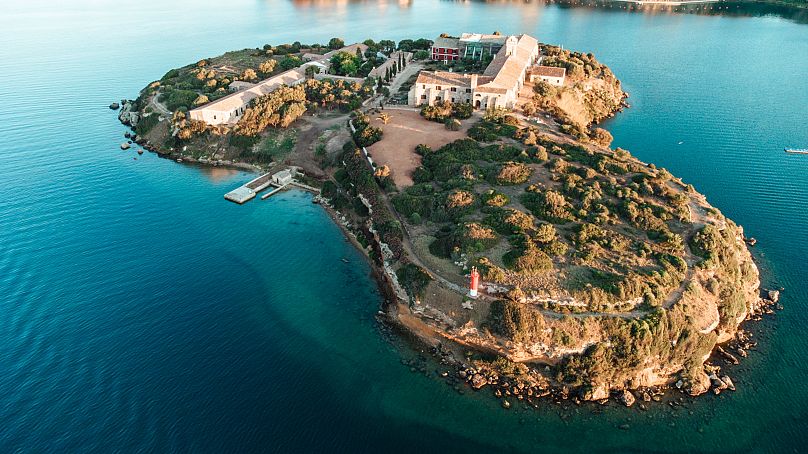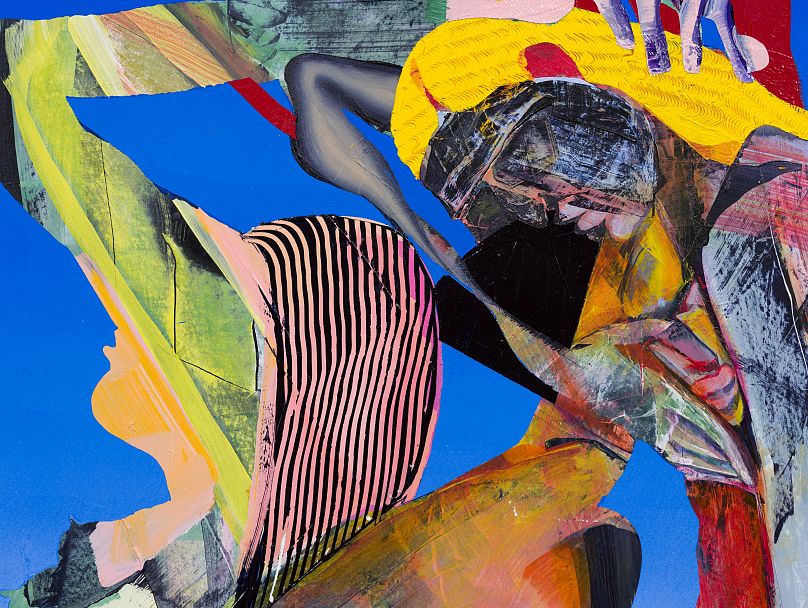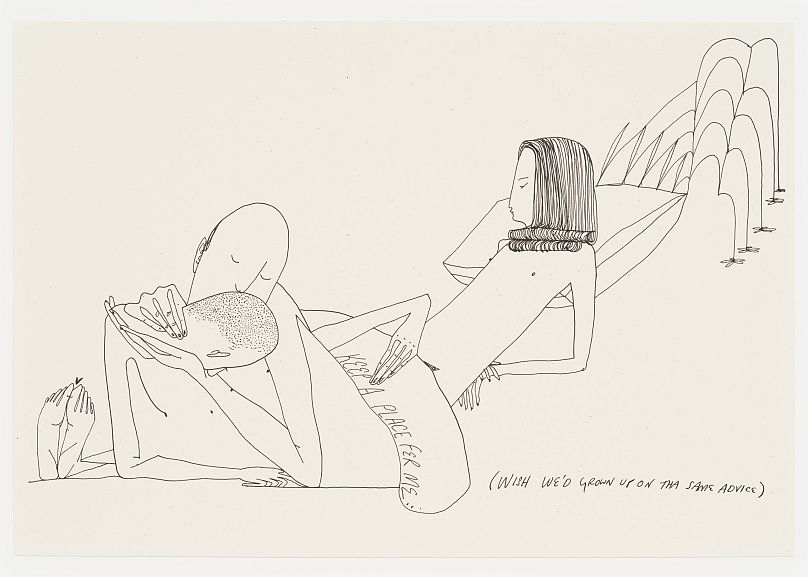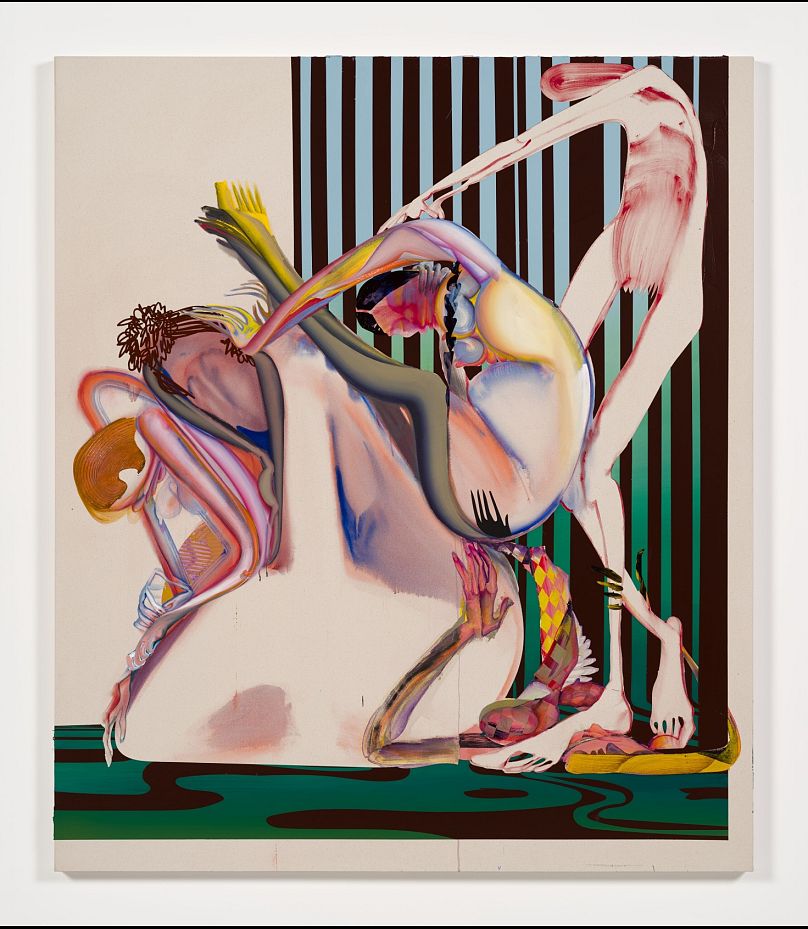Race, sexual identity, queerness and gender are just some of the themes explored by Christina Quarles in her specially commissioned exhibition on the Spanish island of Menorca. Elise Morton visited the show to speak with the rising US star artist about her ideas and inspirations.
Los Angeles-based artist Christina Quarles is famed for her intriguing figurative art, which confronts themes of identity, embodiment and representation.
Informed in part by her identification as a queer, cis-gendered, multiracial woman, Quarles’s work challenges assumptions and meditates on the multiplicity and contradictions that make up a sense of self. This complexity is mirrored in her creative process: blending traditional techniques, TikTok inspiration, and the use of Adobe Illustrator to build her compositions.
Following her participation at last year’s Venice Biennale, Quarles’s trademark distorted bodies – rendered in both brilliant painted colour and line drawing – take centre stage this summer at the artist’s first exhibition in Spain, hosted at Hauser & Wirth on Menorca’s historic (not to mention idyllic) Illa del Rei.
Amid the excitement of the opening of Come In From An Endless Place, Euronews Culture caught up with Quarles to talk identity, technology and Menorca.
Could you tell us something about the concept behind Come In From An Endless Place and its title? Where is this "endless place"?
Like many of my titles, Come In From An Endless Place, is a quote I mis-remembered, something I reiterated phonetically, since I often deal with meaning and legibility in my work. The title also addresses the idea of coming in, or an ongoing return. I'm continuing to think about these cycles in my work, cycles of beauty and monotony, of struggle and ease, of containment that limits, or containment that supports.
The concept of the return is particular to this show, which is held on an island, off another island, in the midst of an expansive sea. A composition that repeats again and again in this body of work, is this sense of doubling over, or knotting, which can be a tangle or alternatively present order in the midst of chaos.
How did you come to be interested in bodies as a form?
I'm really interested in this idea of using the figure to explore what it means to live within a gendered, racialized body. My figures don’t represent the act of looking at a body, but rather, the experience of looking out into the world, and negotiating limits, or possibilities, depending on various social, or personal contexts.
This limitation of being seen a certain way and interpreted based on a vague picture, is something I (and other artists) have long explored and seek to resist. My experience of identity is one that is multiply-situated in simultaneous and often contradictory experiences. I try to render figures that embrace ambiguity, and sometimes, translate an excess of visual information.
Why did you decide to embed digital technology in the process of making your art?
My compositions are determined as I think through a painting – it’s somewhat of a zig-zagging process. I usually paint gestural forms first, allowing for bleeds, drips, and natural occurrences.
At a certain point I interrupt the process, and photograph my work. I then look at the image in Adobe Illustrator, where I map out various planes and patterns, depending on what I’ve produced, creating more architectural elements that can interact with the figures.
Incorporating technology is a way for me to shift from the scale of my arm-span to more of a finger scale, since I create my patterns on a computer screen. At the same time, the digital scale is infinitely expandable, so it offers an interesting intervention with my process.
But physically painting and creating digital patterns, both require a negotiation between intention and accident, or coincidence. Just as bleeds lead to new figures in my paintings, glitches in Illustrator also give way to new ideas and avenues.
Many of your works include text, and particularly phonetically written spoken utterances. How do you think such text impacts the way we look at or read an artwork, and how does this function in a setting like Menorca, where many visitors don't have English as their first language?
My work contends with how we are trained to read an image. Text, or language, can likewise, give way to multiple interpretations.
Early in my career, I would include text in the paintings, but I found that there was too much temptation to latch onto these phrases as captions, or some kind of explanation of the work.
I still include text in my drawings, where it’s more integrated into the planes and figures, and not necessarily read as a description. I also make my drawings with ink, a medium designed for both drawing and writing, so the material gives way to the inclusion of language.
The text I end up including, is often something I read, or overheard, or an aphorism that I end up playing with and reinterpreting. It is, in a way, a translation, and that’s something that pertains to holding an exhibition in Menorca, which, while in Spain, is a place that has its own language, toggling between Spanish and Catalan, depending on context.
Does the fragmentation of the bodies depicted in your work reflect or draw on your own experience, perhaps in terms of your own sense of self or the way you have been perceived or (mis)represented by others?
Again, I come from an experience of living within a body that is multiply-situated and often mis-identified. In my work, I try to represent this experience and defy simple interpretations or categorisation.
The figures contend with this idea; of fitting into a composition, or fitting within the frame, and search for a sense of wholeness despite fragmentation, or the limits of a particular plane, or the edge of the canvas.
Are there any assumptions or beliefs you aim to challenge in your work?
I try to play with expectations, and the processes of interpreting an image at its face. The reason I’m so interested in ambiguity is because it’s actually quite specific.
When we are presented with more information that we’re able to contend with immediately, we have to spend time, to begin to understand what we are looking at, or interacting with. We have this impulse to understand images or people right away, which is something I examine in my work.
Ideally I’d like the viewer to spend time looking at one of my paintings, and to come to their own conclusions, through that process of interpreting and reinterpreting. I’d like for there to be a dialogue, something more than just looking quickly, and moving on.
How did the context shape the works in Come In From An Endless Place?
The gallery is located in such a special place, surrounded by nature and in the middle of the harbour. The works are installed in this historical building, with windows that provide views of the landscape and the sea.
This idea of expanse and knotting, or folding in, is present in the compositions in the exhibition. I hope for this tension to be legible, that there’s a collapse, but also an openness that relates to the surrounding environment.
Come In From An Endless Place is on at Hauser & Wirth Menorca from now until October 29 2023.
Quarles is additionally having her first show in Germany (Collapsed Time), running at Berlin’s Hamburger Bahnhof until September 17 2023.















